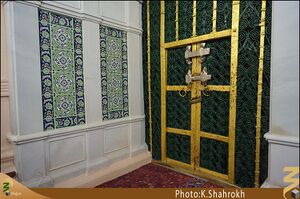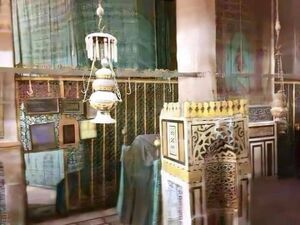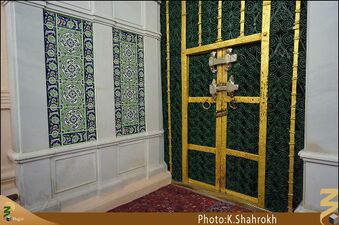Fatima's house: Difference between revisions
No edit summary |
Pourghorbani (talk | contribs) |
||
| (9 intermediate revisions by 2 users not shown) | |||
| Line 59: | Line 59: | ||
==Location== | ==Location== | ||
The house of [[Fatima (a)]], which is also known as the house of Imam 'Ali (a), was located behind the house of the Prophet (a) (the house of 'A'isha).<ref> | The house of [[Fatima (a)]], which is also known as the house of Imam 'Ali (a), was located behind the house of the Prophet (a) (the house of 'A'isha).<ref>Qāʾidān, ''Tārīkh wa āthār-i Islāmi-yi Makka wa Madīna'', p. 203; Ibn Diyāʾ al-Makkī, ''Tārīkh Makka al-musharrafa wa l-Masjid al-Ḥarām'', p. 270. </ref> | ||
Behind this house from the north direction, there was the [[pillar of Tahajjud]]<ref> | Behind this house from the north direction, there was the [[pillar of Tahajjud]]<ref> Samhūdī, ''Wafāʾ al-wafāʾ'', vol. 2, p. 47,58; Ansārī, ''Taʿmīr wa tawsiʿa-yi masjid-i sharīf-i Nabawī'', p. 81; Ibn Diyāʾ al-Makkī, ''Tārīkh Makka al-musharrafa wa l-Masjid al-Ḥarām'', p. 270.</ref> and next to that pillar there was the [[Mihrab of Tahajjud]],<ref>Samhūdī, ''Wafāʾ al-wafāʾ'', vol. 2, p. 47.</ref> where [[Prophet Muhammad (a)]] used to spend the night in that place and pray at night, <ref>Samhūdī, ''Wafāʾ al-wafāʾ'', vol. 2, p. 47.</ref> and now it is the north side of the Prophet's (s).<ref>Jaʿfariyān, ''Āthār-i Islāmī-yi Makka wa Madīna'', p. 219.</ref> If someone stands in the [[Mihrab of Tahjjaud]], [[Bab Jibra'il]] is on his left.<ref>Samhūdī, ''Wafāʾ al-wafāʾ'', vol. 2, p. 47; Ansārī, ''Taʿmīr wa tawsiʿa-yi masjid-i sharīf-i Nabawī'', p. 81; Ibn Diyāʾ al-Makkī, ''Tārīkh Makka al-musharrafa wa l-Masjid al-Ḥarām'', p. 270.</ref> and the of [[Maqam Jibra'il]] is on his right.<ref>Jaʿfariyān, ''Āthār-i Islāmī-yi Makka wa Madīna'', p. 228-229.</ref> | ||
This house was destroyed and now there is no trace of it. Its current location is inside the [[Prophet's (a) room]] and [[Prophet's shrine|shrine]]<ref> | This house was destroyed and now there is no trace of it. Its current location is inside the [[Prophet's (a) room]] and [[Prophet's shrine|shrine]]<ref>Jaʿfariyān, ''Āthār-i Islāmī-yi Makka wa Madīna'', p. 203,210; Baṣīrī, ''Gulwāzhihā-yi ḥajj wa ʿumra'', p. 412.</ref> the sum of these two is called the al-Hujra al-Tahira and its area is about 240 square meters.<ref>Jaʿfariyān, ''Āthār-i Islāmī-yi Makka wa Madīna'', p. 219; Baṣīrī, ''Gulwāzhihā-yi ḥajj wa ʿumra'', p. 412.</ref> | ||
===Doors=== | ===Doors=== | ||
Fatima's house had two doors: a door to the east; that is to the alley, and a door to the west; That is, inside the mosque and parallel to the [[pillar of Wufud]] and [[pillar of Hars|Hars]].<ref> | Fatima's house had two doors: a door to the east; that is to the alley, and a door to the west; That is, inside the mosque and parallel to the [[pillar of Wufud]] and [[pillar of Hars|Hars]].<ref>Qāʾidān, ''Tārīkh wa āthār-i Islāmi-yi Makka wa Madīna'', p. 203; Najmī, ''Tārīkh-i ḥarām-i Aʾimma-yi Baqīʿ'', p. 152.</ref> The door on the west side, which opens to the mosque, was located next to [[Maqam Jibra'il]] ([[Murabba'at al-Qabr Pillar]]).<ref> Ansārī, ''Taʿmīr wa tawsiʿa-yi masjid-i sharīf-i Nabawī'', p. 80,81; Samhūdī, ''Wafāʾ al-wafāʾ'', vol. 2, p. 46,57.</ref>The door that is now known as the door of Fatima's house on the side of [[Bab Jibra'il]] is the same door that opened to the alley.<ref>Qa'idan, Tarikh wa athar-i Islami Makka wa Madina, p. 203.</ref> | ||
== | ==Demolition of Fatima's House and Addition to al-Masjid al-Nabawi== | ||
This house remained until the time of [[al-Walid b. 'Abd al-Malik]], the 'Umayya caliph (Ruled: 86/705-96/714-5). In the expansion of al-Masjid al-Nabawi in the year 88/706-7 by the order of al-Walid and by [['Umar b. 'Abd al-'Aziz]], the governor of Mecca and Medina at the time, [[al-Hasan al-Muthanna]], the son of [[Imam al-Hasan al-Mujtaba (a)]], and [[Fatima, the daughter of Imam Husayn (a)]], who lived there were forced out of it and the house was destroyed and then the house joined to the mosque.<ref>Samhūdī, ''Wafāʾ al-wafāʾ'', vol. 2, p. 89-90.</ref> | |||
== | ==Importance== | ||
According to a | According to a narration, the Prophet (s) went to the door of Fatima's house for forty days and put his hand on the frame of the door and said: "{{ia|اَلسَّلامُ عَلَیکُم یا اهلَ الْبَیت}} peace be upon you, O Ahl al-Bayt (people of the house)" and then recited [[al-Tathir Verse]].<ref>Samhūdī, ''Wafāʾ al-wafāʾ'', vol. 2, p. 46. Wāʿiẓ Khargūshī, ''Sharaf al- Muṣṭafā'', vol. 2, p. 445.</ref> | ||
[[Sadd al-Abwab]] is also considered as one of the signs of importance of the house of Imam 'Ali and Fatima (a) and its residents. According to this narration, the Prophet (s) ordered all the doors of the houses that opened to the mosque to be closed, except for the house of 'Ali and Fatima (a).<ref>Ḥurr al-ʿĀmilī, ''Wasāʾil al-Shīʿa'', vol. 2, p. 205; Kulaynī, ''al-Rawḍa min al-kāfī'', vol. 5, p. 340; Samhūdī, ''Wafāʾ al-wafāʾ'', vol. 2, p. 63,67.</ref> | |||
Also, based on a narration from Prophet ( | Also, based on a narration from Prophet (s), the house of Fatima is considered the best example of the houses mentioned in verse 36 of Sura al-Noor; "In houses Allah has allowed to be raised and wherein His Name is celebrated; He is glorified therein, morning and evening".<ref>Ṭabrisī, ''Majmaʿ al-bayān fī tafsīr al-Qurʾān'' vol. 7, p. 227; Majlisī, ''Biḥār al-anwār'', vol. 23, p. 325; Majlisī, ''Mirʾāt al-ʿuqūl'', vol. 5; p. 68.</ref> | ||
This house is one of the places where it is believed that Fatima (a) was buried.<ref> | This house is one of the places where it is believed that Fatima (a) was buried.<ref>Ṣadūq, ''Man lā yaḥḍuruh al-faqīh'', vol. 2, p. 572; Ṭūsī, ''Tahdhīb al-aḥkām'', vol. 6, p. 9; Qa'idan,''Tarikh wa athar-i Islami Makka wa Madina'', p. 208.</ref> | ||
==Gallery== | ==Gallery== | ||
| Line 88: | Line 84: | ||
file: درب خانه فاطمه.jpg|A door known as the door of Fatima's house in [[al-Masjid al-Nabawi]] | file: درب خانه فاطمه.jpg|A door known as the door of Fatima's house in [[al-Masjid al-Nabawi]] | ||
</gallery> | </gallery> | ||
==Notes== | ==Notes== | ||
{{Notes}} | {{Notes}} | ||
==References== | ==References== | ||
{{References}} | {{References}} | ||
* | *Ansārī, Nājī Muḥammad Ḥasan ʿAbd l-Qādir al-. ''Taʿmīr wa tawsiʿa-yi masjid-i sharīf-i Nabawī''. Translated by ʿAbd l-Muḥammad Āyatī, Tehran: Mashʿar, 1385Sh. | ||
* | *Baṣīrī, ʿAlī Riḍā. ''Gulwāzhihā-yi ḥajj wa ʿumra''. Tehran: Mashʿar, 1387Sh. | ||
* | *Ḥurr al-ʿĀmilī, Muḥammad b. al-Ḥasan al-. ''Wasāʾil al-Shīʿa''. Qom: Muʾassisat Āl al-Bayt, 1414AH. | ||
*Ibn | *Ibn Diyāʾ al-Makkī, Muḥammad b. Aḥmad. ''Tārīkh Makka al-musharrafa wa l-Masjid al-Ḥarām wa l-Madīna al-sharīfa wa l-qabr al-sharīf''. Edited by al-ʿAdwī, Mecca: Maktabat al-Tijārīyya Muṣṭafā Aḥmad al-Bāz, 1416AH. | ||
*Ibn | *Ibn Saʿd, Muḥammad b. Manīʿ al-Ḥāshimī al-Baṣrī. ''Al-Ṭabaqāt al-kubrā''. Edited by Muḥammad ʿAbd al-Qādir ʿAṭāʾ. Beirut: Dar al-Kutub al-ʿIlmiyya, 1410/1990. | ||
* | *Jaʿfariyān, Rasūl. ''Āthār-i Islāmī-yi Makka wa Madīna''. Tehran: Mashʿar, 1382Sh. | ||
* | *Kulaynī, Muḥammad b. Yaʿqūb al-. ''Al-Rawḍa min al-kāfī''. Edited by ʿAlī Akbar Ghaffārī. Tehran: 1389AH. | ||
* | *Majlisī, Muḥammad Bāqir al-. ''Biḥār al-anwār''. Beirut: Dār Iḥyāʾ al-Turāth al-ʿArabī, 1403AH. | ||
* | *Majlisī, Muḥammad Bāqir al-. ''Mirʾāt al-ʿuqūl''. Edited by Rasūlī Maḥallātī. Tehran: Dār al-Kutub al-Islāmiyya, 1404 AH. | ||
* | *Najmī, Muḥammad Ṣādiq. ''Tārīkh-i ḥarām-i Aʾimma-yi Baqīʿ wa āthār-i digār dar Madīna-yi munawwara''. Tehran: Mashʿar, 1386Sh. | ||
* | *Qāʾidān, Aṣghar. ''Tārīkh wa āthār-i Islāmi-yi Makka wa Madīna''. Qom: Nashr-i Mashʿar, 1381Sh. | ||
* | *Ṣadūq, Muḥammad b. ʿAlī al-. ''Man lā yaḥḍuruh al-faqīh''. Edited by ʿAlī Akbar Ghaffārī. Qom: Intishārāt-i Islāmī, 1413AH. | ||
* | *Samhūdī, ʿAlī b. ʿAbd Allāh. ''Wafāʾ al-wafāʾ bi akhbār dar al-Muṣṭafā''. Edited by Muḥammad Muḥyi l-Dīn ʿAbd al-Ḥamīd. Beirut: 1984. | ||
* | *Ṭabrisī, al-Faḍl b. al-Ḥasan al-. ''Majmaʿ al-bayān fī tafsīr al-Qurʾān''. Edited by Muḥammad Jawād Balāghī. Tehran: Intishārāt-i Nāṣir Khusruw, 1372Sh. | ||
* | *Ṭūsī, Muḥammad b. al-Ḥasan al-. ''Tahdhīb al-aḥkām''. Tehran: Dār al-Kutub al-Islāmīyya, 1407AH. | ||
* | *Wāʿiẓ Khargūshī, ʿAbd al-Malik. ''Sharaf al- Muṣṭafā''. Mecca: Dār al-Bashāʾir, 1424AH. | ||
{{end}} | {{end}} | ||
[[fa:خانه فاطمه(س)]] | [[fa:خانه فاطمه(س)]] | ||
Revision as of 15:28, 26 November 2023
 A door known as the door of Fatima's house in al-Masjid al-Nabawi | |
| General Information | |
|---|---|
| Other Names | The house of Imam Ali (a), the house of Ali (a) and Fatima (a) |
| Place | Medina, al-Masjid al-Nabawi |
| Religious Aspect | |
| Religious Affiliation | Shia |
| Beliefs | The possible burial place of Fatima (a) |
| History | |
| Time of Construction | Early Islam |
| Events | Attack on Fatima's house |
Fatima's house or room, is the house where Lady Fatima (a), the daughter of the Prophet Muhammad (a), lived after marrying Imam 'Ali (a) and was located next to al-Masjid al-Nabawi and next to the house of the Prophet and 'A'isha. This house has been destroyed today and its current location is inside al-Masjid al-Nabawi and within the area of the Prophet's room and shrine.
In the historical sources, another house is also mentioned in Medina next to the al-Baqi' cemetery for Imam 'Ali (a). There is a different opinion about whether the events after the demise of the Prophet (s) took place in the house of Fatima (a) or in the house of Imam 'Ali (a).
Fatima's house in al-Masjid al-Nabawi is one of the possible burial places of Lady Fatima (a).
Location
The house of Fatima (a), which is also known as the house of Imam 'Ali (a), was located behind the house of the Prophet (a) (the house of 'A'isha).[1] Behind this house from the north direction, there was the pillar of Tahajjud[2] and next to that pillar there was the Mihrab of Tahajjud,[3] where Prophet Muhammad (a) used to spend the night in that place and pray at night, [4] and now it is the north side of the Prophet's (s).[5] If someone stands in the Mihrab of Tahjjaud, Bab Jibra'il is on his left.[6] and the of Maqam Jibra'il is on his right.[7]
This house was destroyed and now there is no trace of it. Its current location is inside the Prophet's (a) room and shrine[8] the sum of these two is called the al-Hujra al-Tahira and its area is about 240 square meters.[9]
Doors
Fatima's house had two doors: a door to the east; that is to the alley, and a door to the west; That is, inside the mosque and parallel to the pillar of Wufud and Hars.[10] The door on the west side, which opens to the mosque, was located next to Maqam Jibra'il (Murabba'at al-Qabr Pillar).[11]The door that is now known as the door of Fatima's house on the side of Bab Jibra'il is the same door that opened to the alley.[12]
Demolition of Fatima's House and Addition to al-Masjid al-Nabawi
This house remained until the time of al-Walid b. 'Abd al-Malik, the 'Umayya caliph (Ruled: 86/705-96/714-5). In the expansion of al-Masjid al-Nabawi in the year 88/706-7 by the order of al-Walid and by 'Umar b. 'Abd al-'Aziz, the governor of Mecca and Medina at the time, al-Hasan al-Muthanna, the son of Imam al-Hasan al-Mujtaba (a), and Fatima, the daughter of Imam Husayn (a), who lived there were forced out of it and the house was destroyed and then the house joined to the mosque.[13]
Importance
According to a narration, the Prophet (s) went to the door of Fatima's house for forty days and put his hand on the frame of the door and said: "اَلسَّلامُ عَلَیکُم یا اهلَ الْبَیت peace be upon you, O Ahl al-Bayt (people of the house)" and then recited al-Tathir Verse.[14]
Sadd al-Abwab is also considered as one of the signs of importance of the house of Imam 'Ali and Fatima (a) and its residents. According to this narration, the Prophet (s) ordered all the doors of the houses that opened to the mosque to be closed, except for the house of 'Ali and Fatima (a).[15]
Also, based on a narration from Prophet (s), the house of Fatima is considered the best example of the houses mentioned in verse 36 of Sura al-Noor; "In houses Allah has allowed to be raised and wherein His Name is celebrated; He is glorified therein, morning and evening".[16]
This house is one of the places where it is believed that Fatima (a) was buried.[17]
Gallery
-
A mihrab known as Mihrab of Fatima, which is located in the area of Fatima's house in the Prophet's Shrine section..
-
A door known as the door of Fatima's house in al-Masjid al-Nabawi
Notes
- ↑ Qāʾidān, Tārīkh wa āthār-i Islāmi-yi Makka wa Madīna, p. 203; Ibn Diyāʾ al-Makkī, Tārīkh Makka al-musharrafa wa l-Masjid al-Ḥarām, p. 270.
- ↑ Samhūdī, Wafāʾ al-wafāʾ, vol. 2, p. 47,58; Ansārī, Taʿmīr wa tawsiʿa-yi masjid-i sharīf-i Nabawī, p. 81; Ibn Diyāʾ al-Makkī, Tārīkh Makka al-musharrafa wa l-Masjid al-Ḥarām, p. 270.
- ↑ Samhūdī, Wafāʾ al-wafāʾ, vol. 2, p. 47.
- ↑ Samhūdī, Wafāʾ al-wafāʾ, vol. 2, p. 47.
- ↑ Jaʿfariyān, Āthār-i Islāmī-yi Makka wa Madīna, p. 219.
- ↑ Samhūdī, Wafāʾ al-wafāʾ, vol. 2, p. 47; Ansārī, Taʿmīr wa tawsiʿa-yi masjid-i sharīf-i Nabawī, p. 81; Ibn Diyāʾ al-Makkī, Tārīkh Makka al-musharrafa wa l-Masjid al-Ḥarām, p. 270.
- ↑ Jaʿfariyān, Āthār-i Islāmī-yi Makka wa Madīna, p. 228-229.
- ↑ Jaʿfariyān, Āthār-i Islāmī-yi Makka wa Madīna, p. 203,210; Baṣīrī, Gulwāzhihā-yi ḥajj wa ʿumra, p. 412.
- ↑ Jaʿfariyān, Āthār-i Islāmī-yi Makka wa Madīna, p. 219; Baṣīrī, Gulwāzhihā-yi ḥajj wa ʿumra, p. 412.
- ↑ Qāʾidān, Tārīkh wa āthār-i Islāmi-yi Makka wa Madīna, p. 203; Najmī, Tārīkh-i ḥarām-i Aʾimma-yi Baqīʿ, p. 152.
- ↑ Ansārī, Taʿmīr wa tawsiʿa-yi masjid-i sharīf-i Nabawī, p. 80,81; Samhūdī, Wafāʾ al-wafāʾ, vol. 2, p. 46,57.
- ↑ Qa'idan, Tarikh wa athar-i Islami Makka wa Madina, p. 203.
- ↑ Samhūdī, Wafāʾ al-wafāʾ, vol. 2, p. 89-90.
- ↑ Samhūdī, Wafāʾ al-wafāʾ, vol. 2, p. 46. Wāʿiẓ Khargūshī, Sharaf al- Muṣṭafā, vol. 2, p. 445.
- ↑ Ḥurr al-ʿĀmilī, Wasāʾil al-Shīʿa, vol. 2, p. 205; Kulaynī, al-Rawḍa min al-kāfī, vol. 5, p. 340; Samhūdī, Wafāʾ al-wafāʾ, vol. 2, p. 63,67.
- ↑ Ṭabrisī, Majmaʿ al-bayān fī tafsīr al-Qurʾān vol. 7, p. 227; Majlisī, Biḥār al-anwār, vol. 23, p. 325; Majlisī, Mirʾāt al-ʿuqūl, vol. 5; p. 68.
- ↑ Ṣadūq, Man lā yaḥḍuruh al-faqīh, vol. 2, p. 572; Ṭūsī, Tahdhīb al-aḥkām, vol. 6, p. 9; Qa'idan,Tarikh wa athar-i Islami Makka wa Madina, p. 208.
References
- Ansārī, Nājī Muḥammad Ḥasan ʿAbd l-Qādir al-. Taʿmīr wa tawsiʿa-yi masjid-i sharīf-i Nabawī. Translated by ʿAbd l-Muḥammad Āyatī, Tehran: Mashʿar, 1385Sh.
- Baṣīrī, ʿAlī Riḍā. Gulwāzhihā-yi ḥajj wa ʿumra. Tehran: Mashʿar, 1387Sh.
- Ḥurr al-ʿĀmilī, Muḥammad b. al-Ḥasan al-. Wasāʾil al-Shīʿa. Qom: Muʾassisat Āl al-Bayt, 1414AH.
- Ibn Diyāʾ al-Makkī, Muḥammad b. Aḥmad. Tārīkh Makka al-musharrafa wa l-Masjid al-Ḥarām wa l-Madīna al-sharīfa wa l-qabr al-sharīf. Edited by al-ʿAdwī, Mecca: Maktabat al-Tijārīyya Muṣṭafā Aḥmad al-Bāz, 1416AH.
- Ibn Saʿd, Muḥammad b. Manīʿ al-Ḥāshimī al-Baṣrī. Al-Ṭabaqāt al-kubrā. Edited by Muḥammad ʿAbd al-Qādir ʿAṭāʾ. Beirut: Dar al-Kutub al-ʿIlmiyya, 1410/1990.
- Jaʿfariyān, Rasūl. Āthār-i Islāmī-yi Makka wa Madīna. Tehran: Mashʿar, 1382Sh.
- Kulaynī, Muḥammad b. Yaʿqūb al-. Al-Rawḍa min al-kāfī. Edited by ʿAlī Akbar Ghaffārī. Tehran: 1389AH.
- Majlisī, Muḥammad Bāqir al-. Biḥār al-anwār. Beirut: Dār Iḥyāʾ al-Turāth al-ʿArabī, 1403AH.
- Majlisī, Muḥammad Bāqir al-. Mirʾāt al-ʿuqūl. Edited by Rasūlī Maḥallātī. Tehran: Dār al-Kutub al-Islāmiyya, 1404 AH.
- Najmī, Muḥammad Ṣādiq. Tārīkh-i ḥarām-i Aʾimma-yi Baqīʿ wa āthār-i digār dar Madīna-yi munawwara. Tehran: Mashʿar, 1386Sh.
- Qāʾidān, Aṣghar. Tārīkh wa āthār-i Islāmi-yi Makka wa Madīna. Qom: Nashr-i Mashʿar, 1381Sh.
- Ṣadūq, Muḥammad b. ʿAlī al-. Man lā yaḥḍuruh al-faqīh. Edited by ʿAlī Akbar Ghaffārī. Qom: Intishārāt-i Islāmī, 1413AH.
- Samhūdī, ʿAlī b. ʿAbd Allāh. Wafāʾ al-wafāʾ bi akhbār dar al-Muṣṭafā. Edited by Muḥammad Muḥyi l-Dīn ʿAbd al-Ḥamīd. Beirut: 1984.
- Ṭabrisī, al-Faḍl b. al-Ḥasan al-. Majmaʿ al-bayān fī tafsīr al-Qurʾān. Edited by Muḥammad Jawād Balāghī. Tehran: Intishārāt-i Nāṣir Khusruw, 1372Sh.
- Ṭūsī, Muḥammad b. al-Ḥasan al-. Tahdhīb al-aḥkām. Tehran: Dār al-Kutub al-Islāmīyya, 1407AH.
- Wāʿiẓ Khargūshī, ʿAbd al-Malik. Sharaf al- Muṣṭafā. Mecca: Dār al-Bashāʾir, 1424AH.

